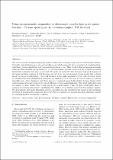Files in this item
Using zircon in mafic migmatites to disentangle complex high-grade gneiss terrains – Terrane spotting in the Lewisian complex, NW Scotland
Item metadata
| dc.contributor.author | Fischer, Sebastian | |
| dc.contributor.author | Prave, Anthony | |
| dc.contributor.author | Johnson, Tim | |
| dc.contributor.author | Cawood, Peter Anthony | |
| dc.contributor.author | Hawkesworth, Chris | |
| dc.contributor.author | Horstwood, Matthew | |
| dc.contributor.author | EIMF | |
| dc.date.accessioned | 2022-01-23T00:38:52Z | |
| dc.date.available | 2022-01-23T00:38:52Z | |
| dc.date.issued | 2021-04 | |
| dc.identifier | 272349883 | |
| dc.identifier | aa3afc15-dd2b-45b3-a73e-0f2d65e2f2af | |
| dc.identifier | 85099691776 | |
| dc.identifier | 000652026000004 | |
| dc.identifier.citation | Fischer , S , Prave , A , Johnson , T , Cawood , P A , Hawkesworth , C , Horstwood , M & EIMF 2021 , ' Using zircon in mafic migmatites to disentangle complex high-grade gneiss terrains – Terrane spotting in the Lewisian complex, NW Scotland ' , Precambrian Research , vol. 355 , 106074 . https://doi.org/10.1016/j.precamres.2020.106074 | en |
| dc.identifier.issn | 0301-9268 | |
| dc.identifier.other | ORCID: /0000-0002-4614-3774/work/87845396 | |
| dc.identifier.uri | https://hdl.handle.net/10023/24736 | |
| dc.description | This research was part of SF’s PhD studies, and he acknowledges a 600 Year Anniversary Scholarship from the University of St Andrews. Analyses were funded through grants with EIMF (IMF545/1114) and NIGL (IP-1473-1114). Fieldwork was funded by NERC grant NE/J021822/1 to PAC. TEJ acknowledges funding from Australian Research Council Discovery Project DP200101104 and support from the State Key Laboratory for Geological Processes and Mineral Resources, China University of Geosciences, Wuhan (Open Fund GPMR201903). PAC acknowledges support from Australian Research Council grant FL160100168. CJH acknowledges support from Leverhulme Trust grants RPG-2015-422 and EM-2017-047\4. | en |
| dc.description.abstract | The zircon record of complex high-grade gneiss terrains is key to interpreting their tectonothermal evolution. Typically, such studies focus on zircon-rich, felsic rocks, which commonly have a complicated (partial melting, inheritance, partial dissolution, and reprecipitation) zircon record. Here we show that metamorphosed mafic rocks and their retained partial melts (i.e. in situ leucosomes) provide a record of the evolution of crustal blocks that is simpler and easier to interpret. We apply our method to the Archaean high-grade gneisses of the iconic Lewisian complex of NW Scotland and use it to test the proposed terrane model that is based largely on zircon geochronology. Our work focusses on the mafic migmatites of the central region, where we identified the long-established metamorphic age clusters of ca. 2.75 Ga and 2.5 Ga, as well as ca. 2.85 Ga protolith ages. A key finding is that these ages are recognised across both putative terrane blocks of the central region previously proposed to record different tectonothermal histories. Our oldest (inherited) ages are similar to those within other blocks outside the central region. Thus, all these blocks likely share a common pre-metamorphic history, questioning the validity of the terrane model for the Lewisian complex. We demonstrate that mafic lithologies provide a powerful tool for identifying key stages in the polyphase evolution of metamorphic complexes that typify Earth’s earliest rock records and offer additional context for assessing Earth’s geodynamic evolution. | |
| dc.format.extent | 4571654 | |
| dc.language.iso | eng | |
| dc.relation.ispartof | Precambrian Research | en |
| dc.subject | Zircon | en |
| dc.subject | Mafic rocks | en |
| dc.subject | Geochronology | en |
| dc.subject | Lewisian | en |
| dc.subject | Terranes | en |
| dc.subject | Hf isotopes | en |
| dc.subject | Archaen | en |
| dc.subject | Migmatites | en |
| dc.subject | GE Environmental Sciences | en |
| dc.subject | DAS | en |
| dc.subject.lcc | GE | en |
| dc.title | Using zircon in mafic migmatites to disentangle complex high-grade gneiss terrains – Terrane spotting in the Lewisian complex, NW Scotland | en |
| dc.type | Journal article | en |
| dc.contributor.sponsor | NERC | en |
| dc.contributor.institution | University of St Andrews. School of Earth & Environmental Sciences | en |
| dc.identifier.doi | https://doi.org/10.1016/j.precamres.2020.106074 | |
| dc.description.status | Peer reviewed | en |
| dc.date.embargoedUntil | 2022-01-23 | |
| dc.identifier.url | https://www.sciencedirect.com/science/article/pii/S030192682030663X#s0125 | en |
| dc.identifier.grantnumber | NE/J021822/1 | en |
This item appears in the following Collection(s)
Items in the St Andrews Research Repository are protected by copyright, with all rights reserved, unless otherwise indicated.

